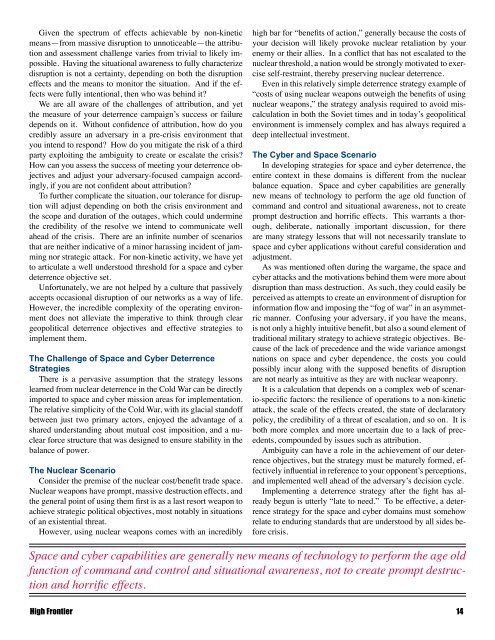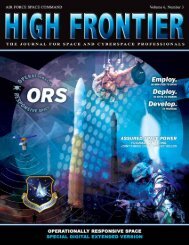Schriever Wargame 2010 - Air Force Space Command
Schriever Wargame 2010 - Air Force Space Command
Schriever Wargame 2010 - Air Force Space Command
- No tags were found...
Create successful ePaper yourself
Turn your PDF publications into a flip-book with our unique Google optimized e-Paper software.
Given the spectrum of effects achievable by non-kinetic<br />
means—from massive disruption to unnoticeable—the attribution<br />
and assessment challenge varies from trivial to likely impossible.<br />
Having the situational awareness to fully characterize<br />
disruption is not a certainty, depending on both the disruption<br />
effects and the means to monitor the situation. And if the effects<br />
were fully intentional, then who was behind it<br />
We are all aware of the challenges of attribution, and yet<br />
the measure of your deterrence campaign’s success or failure<br />
depends on it. Without confidence of attribution, how do you<br />
credibly assure an adversary in a pre-crisis environment that<br />
you intend to respond How do you mitigate the risk of a third<br />
party exploiting the ambiguity to create or escalate the crisis<br />
How can you assess the success of meeting your deterrence objectives<br />
and adjust your adversary-focused campaign accordingly,<br />
if you are not confident about attribution<br />
To further complicate the situation, our tolerance for disruption<br />
will adjust depending on both the crisis environment and<br />
the scope and duration of the outages, which could undermine<br />
the credibility of the resolve we intend to communicate well<br />
ahead of the crisis. There are an infinite number of scenarios<br />
that are neither indicative of a minor harassing incident of jamming<br />
nor strategic attack. For non-kinetic activity, we have yet<br />
to articulate a well understood threshold for a space and cyber<br />
deterrence objective set.<br />
Unfortunately, we are not helped by a culture that passively<br />
accepts occasional disruption of our networks as a way of life.<br />
However, the incredible complexity of the operating environment<br />
does not alleviate the imperative to think through clear<br />
geopolitical deterrence objectives and effective strategies to<br />
implement them.<br />
The Challenge of <strong>Space</strong> and Cyber Deterrence<br />
Strategies<br />
There is a pervasive assumption that the strategy lessons<br />
learned from nuclear deterrence in the Cold War can be directly<br />
imported to space and cyber mission areas for implementation.<br />
The relative simplicity of the Cold War, with its glacial standoff<br />
between just two primary actors, enjoyed the advantage of a<br />
shared understanding about mutual cost imposition, and a nuclear<br />
force structure that was designed to ensure stability in the<br />
balance of power.<br />
The Nuclear Scenario<br />
Consider the premise of the nuclear cost/benefit trade space.<br />
Nuclear weapons have prompt, massive destruction effects, and<br />
the general point of using them first is as a last resort weapon to<br />
achieve strategic political objectives, most notably in situations<br />
of an existential threat.<br />
However, using nuclear weapons comes with an incredibly<br />
high bar for “benefits of action,” generally because the costs of<br />
your decision will likely provoke nuclear retaliation by your<br />
enemy or their allies. In a conflict that has not escalated to the<br />
nuclear threshold, a nation would be strongly motivated to exercise<br />
self-restraint, thereby preserving nuclear deterrence.<br />
Even in this relatively simple deterrence strategy example of<br />
“costs of using nuclear weapons outweigh the benefits of using<br />
nuclear weapons,” the strategy analysis required to avoid miscalculation<br />
in both the Soviet times and in today’s geopolitical<br />
environment is immensely complex and has always required a<br />
deep intellectual investment.<br />
The Cyber and <strong>Space</strong> Scenario<br />
In developing strategies for space and cyber deterrence, the<br />
entire context in these domains is different from the nuclear<br />
balance equation. <strong>Space</strong> and cyber capabilities are generally<br />
new means of technology to perform the age old function of<br />
command and control and situational awareness, not to create<br />
prompt destruction and horrific effects. This warrants a thorough,<br />
deliberate, nationally important discussion, for there<br />
are many strategy lessons that will not necessarily translate to<br />
space and cyber applications without careful consideration and<br />
adjustment.<br />
As was mentioned often during the wargame, the space and<br />
cyber attacks and the motivations behind them were more about<br />
disruption than mass destruction. As such, they could easily be<br />
perceived as attempts to create an environment of disruption for<br />
information flow and imposing the “fog of war” in an asymmetric<br />
manner. Confusing your adversary, if you have the means,<br />
is not only a highly intuitive benefit, but also a sound element of<br />
traditional military strategy to achieve strategic objectives. Because<br />
of the lack of precedence and the wide variance amongst<br />
nations on space and cyber dependence, the costs you could<br />
possibly incur along with the supposed benefits of disruption<br />
are not nearly as intuitive as they are with nuclear weaponry.<br />
It is a calculation that depends on a complex web of scenario-specific<br />
factors: the resilience of operations to a non-kinetic<br />
attack, the scale of the effects created, the state of declaratory<br />
policy, the credibility of a threat of escalation, and so on. It is<br />
both more complex and more uncertain due to a lack of precedents,<br />
compounded by issues such as attribution.<br />
Ambiguity can have a role in the achievement of our deterrence<br />
objectives, but the strategy must be maturely formed, effectively<br />
influential in reference to your opponent’s perceptions,<br />
and implemented well ahead of the adversary’s decision cycle.<br />
Implementing a deterrence strategy after the fight has already<br />
begun is utterly “late to need.” To be effective, a deterrence<br />
strategy for the space and cyber domains must somehow<br />
relate to enduring standards that are understood by all sides before<br />
crisis.<br />
<strong>Space</strong> and cyber capabilities are generally new means of technology to perform the age old<br />
function of command and control and situational awareness, not to create prompt destruction<br />
and horrific effects.<br />
High Frontier 14











